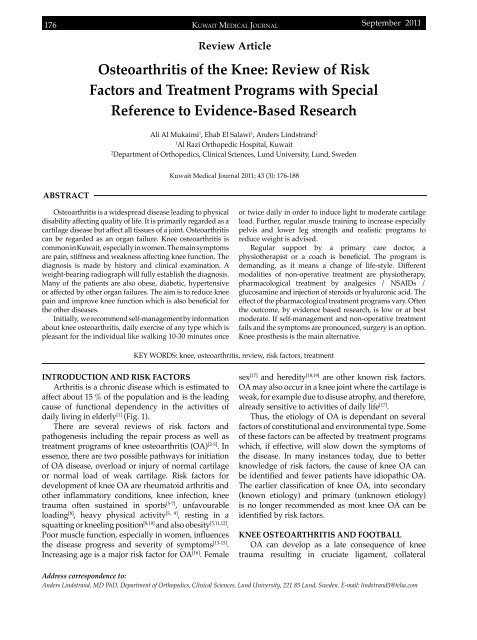Vol 43 # 3 September 2011 - Kma.org.kw
Vol 43 # 3 September 2011 - Kma.org.kw
Vol 43 # 3 September 2011 - Kma.org.kw
You also want an ePaper? Increase the reach of your titles
YUMPU automatically turns print PDFs into web optimized ePapers that Google loves.
176<br />
KUWAIT MEDICAL JOURNAL<br />
<strong>September</strong> <strong>2011</strong><br />
Review Article<br />
Osteoarthritis of the Knee: Review of Risk<br />
Factors and Treatment Programs with Special<br />
Reference to Evidence-Based Research<br />
Ali Al Mukaimi 1 , Ehab El Salawi 1 , Anders Lindstrand 2<br />
1<br />
Al Razi Orthopedic Hospital, Kuwait<br />
2<br />
Department of Orthopedics, Clinical Sciences, Lund University, Lund, Sweden<br />
Kuwait Medical Journal <strong>2011</strong>; <strong>43</strong> (3): 176-188<br />
ABSTRACT<br />
Osteoarthritis is a widespread disease leading to physical<br />
disability affecting quality of life. It is primarily regarded as a<br />
cartilage disease but affect all tissues of a joint. Osteoarthritis<br />
can be regarded as an <strong>org</strong>an failure. Knee osteoarthritis is<br />
common in Kuwait, especially in women. The main symptoms<br />
are pain, stiffness and weakness affecting knee function. The<br />
diagnosis is made by history and clinical examination. A<br />
weight-bearing radiograph will fully establish the diagnosis.<br />
Many of the patients are also obese, diabetic, hypertensive<br />
or affected by other <strong>org</strong>an failures. The aim is to reduce knee<br />
pain and improve knee function which is also beneficial for<br />
the other diseases.<br />
Initially, we recommend self-management by information<br />
about knee osteoarthritis, daily exercise of any type which is<br />
pleasant for the individual like walking 10-30 minutes once<br />
or twice daily in order to induce light to moderate cartilage<br />
load. Further, regular muscle training to increase especially<br />
pelvis and lower leg strength and realistic programs to<br />
reduce weight is advised.<br />
Regular support by a primary care doctor, a<br />
physiotherapist or a coach is beneficial. The program is<br />
demanding, as it means a change of life-style. Different<br />
modalities of non-operative treatment are physiotherapy,<br />
pharmacological treatment by analgesics / NSAIDs /<br />
glucosamine and injection of steroids or hyaluronic acid. The<br />
effect of the pharmacological treatment programs vary. Often<br />
the outcome, by evidence based research, is low or at best<br />
moderate. If self-management and non-operative treatment<br />
fails and the symptoms are pronounced, surgery is an option.<br />
Knee prosthesis is the main alternative.<br />
KEY WORDS: knee, osteoarthritis, review, risk factors, treatment<br />
INTRODUCTION AND RISK FACTORS<br />
Arthritis is a chronic disease which is estimated to<br />
affect about 15 % of the population and is the leading<br />
cause of functional dependency in the activities of<br />
daily living in elderly [1] (Fig. 1).<br />
There are several reviews of risk factors and<br />
pathogenesis including the repair process as well as<br />
treatment programs of knee osteoarthritis (OA) [2-5] . In<br />
essence, there are two possible pathways for initiation<br />
of OA disease, overload or injury of normal cartilage<br />
or normal load of weak cartilage. Risk factors for<br />
development of knee OA are rheumatoid arthritis and<br />
other inflammatory conditions, knee infection, knee<br />
trauma often sustained in sports [5-7] , unfavourable<br />
loading [8] , heavy physical activity [5, 9] , resting in a<br />
squatting or kneeling position [8,10] and also obesity [5,11,12] .<br />
Poor muscle function, especially in women, influences<br />
the disease progress and severity of symptoms [13-15] .<br />
Increasing age is a major risk factor for OA [16] . Female<br />
sex [17] and heredity [18,19] are other known risk factors.<br />
OA may also occur in a knee joint where the cartilage is<br />
weak, for example due to disuse atrophy, and therefore,<br />
already sensitive to activities of daily life [17] .<br />
Thus, the etiology of OA is dependant on several<br />
factors of constitutional and environmental type. Some<br />
of these factors can be affected by treatment programs<br />
which, if effective, will slow down the symptoms of<br />
the disease. In many instances today, due to better<br />
knowledge of risk factors, the cause of knee OA can<br />
be identified and fewer patients have idiopathic OA.<br />
The earlier classification of knee OA, into secondary<br />
(known etiology) and primary (unknown etiology)<br />
is no longer recommended as most knee OA can be<br />
identified by risk factors.<br />
KNEE OSTEOARTHRITIS AND FOOTBALL<br />
OA can develop as a late consequence of knee<br />
trauma resulting in cruciate ligament, collateral<br />
Address correspondence to:<br />
Anders Lindstrand, MD PhD, Department of Orthopedics, Clinical Sciences, Lund University, 221 85 Lund, Sweden. E-mail: lindstrand5@telia.com
















